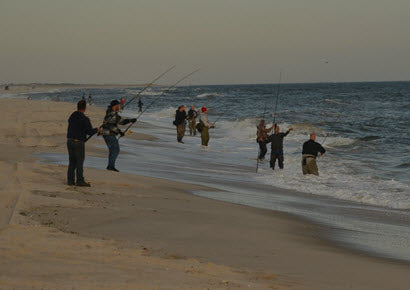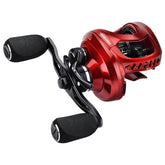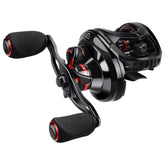
Surface Poppers…Bam, Fish On!
Its 5 a.m. and false dawn is beginning to light the horizon. You methodically work your popper slowly across a rip a couple hundred feet from shore. As the lure dances into the strike zone you see a swirl, and then within seconds a huge eruption of water appears - thanks to the 30-pound striper that has just mauled your lure! And that my friends is why I love casting surface plugs, especially ones that pop, splash or make a commotion.
As in any fishing situation, working poppers is not just a cast and retrieve event like when you use a tin, or sit and wait while tossing a chunk of bunker or clam on a weighted rig. For poppers, you have to work the rod tip and vary the retrieve to make them dance the “right” way.
LITTLE NECK OR POLARIS
For standard poppers like the Super Strike Little Neck or old stand-by Gibbs Polaris, the work is easier, but it’s still something you’ll need to practice. I have been fishing the surf in the Northeast for over 40 years, and I can tell you the biggest mistake I see when working poppers like these is trying to fish them too “fast.”
Sure, working it fast is easy, and keeps it really chugging along on the surface. In reality though, you are trying to emulate a wounded or weak baitfish for the most part. And, don’t you think a wounded baitfish is more apt to be an easy target for a striped bass or bluefish?
Over the years, I have seen a lot of anglers work plugs, and by far the best was Don Musso of Super Strike fame. And trust me, when Don works a popper, it barely comes towards you any faster than a snail could while walking across concrete!
Don’s method, and one I have found to be the best, is to slow the retrieve down enough to keep the lure on the surface, and keep the lure methodically popping in a rhythmic fashion. Reel, slowly, two to three cranks, then pop; reel slowly, two to three cranks, then pop, etc. The key is making sure the lure remains active, but also stays in the strike zone for the maximum amount of time.
PENCIL POPPERS
No other popper will produce strikes, and vicious ones, like the pencil popper. And, no other popper will see countless misses by anglers then the pencil popper!
The key to a pencil popper is the correct way to work it, then understanding when to set the hook. The pencil is really an easy plug to master, but takes an understanding of the method to perform well. Remember when you were a kid and you tried the old rub your belly and pat your head at the same time? Some of us could do it with ease, while others looked downright awkward to say the least. A good presentation of a pencil popper requires the same brain to hand and coordination as this small, but sometimes frustrating feat.
The art of using a pencil popper comes from reeling in the plug as slow as possible – left side of the brain (left hand), all while causing the popper to agitate in the water by pulsating the rod (right hand). Although seasoned surf fisherman will make the feat look easy, within a short period of time, novice surf anglers can master the technique.
Follow these tips closely! The cast is just as important as the retrieve. As your plug is sailing through the air, you must be ready to take up the slack line as quick as possible when the plug touches down, and begin your retrieve. Make your cast and watch the plug. As it hits the water, flip the bail, or put the line on the line roller (for reels without bails) and reel fast until the plug just begins to move. At the same time, you must place the line between your thumb and forefinger, and slide your hand – with line in place – to just below the first guide. After reaching this area, begin pulsating the rod tip by pushing down on the blank repeatedly. This will cause the popper to jerk back and forth in a side-to-side motion. Here comes the tricky part. While you are pulsating your rod tip in a fast-paced manner, you must reel in the line ever so slowly. This will keep the plug in the strike zone, imitating a wounded baitfish.

Bluefish, especially larger ones, cannot resist a popper worked on the surface.
THE HOOK SET
As stated above, poppers, in my opinion will get more strikes than most any fishing lure you throw, but you will also lose more fish on a popper than most as well. The reason is simple, and patience before the hook-set will make the difference between hooking up, and watching others catch!
In most fishing situations, when you detect a bite, or a smack on your lure, you set the hook. With poppers, you need to re-train your brain. With poppers, when a fish crashes your plug, you need to stop pulsing the rod and reel slowly. Once you feel solid weight at the end of your line that is when you set the hook. If you do not feel weight, go back to pulsing the rod, or slowly popping depending on whether you are using a standard popper or a pencil popper.
SLIGHT ALTERATIONS
With either the pencil popper or little neck popper there are a few minor modifications I have tried, and they appear to work quite well. The first is to remove the rear treble hook on a 3-ounce Little Neck and change the belly hook to a 4/0 or 5/0. In my opinion, this change makes the plug “pop” louder (more surface splash) and with the rear hook off, makes the heavier 3-ounce cast a lot better. On either plug, changing to a larger 4/0 hook also aides in hooking, and landing those outsized stripers and chopper bluefish.
Regardless of where you fish from Maine to Florida and every point in between, surface poppers need to be in your fishing lure arsenal. They will invoke amazing strikes, and probably from the largest fish in the area.

Notice the rear hook is removed on the 3-ounce Little Neck? This will make the lure louder, and cast better.

When the fish are blitzing, pencil poppers will cull out the largest fish in amongst the fray.
Tom Melton is an expert in all aspects of inshore saltwater fishing and freshwater fishing. As an authority on angling he strives to excel while teaching others, and in his own outdoors adventures. Whether it is a freshwater bass fishing tournament, or recreational fishing with family, his skills and knowledge always shine. Tom has been an outdoor writer for more than three decades.












